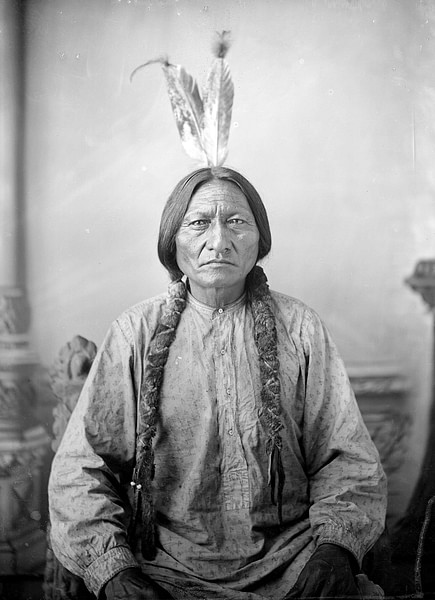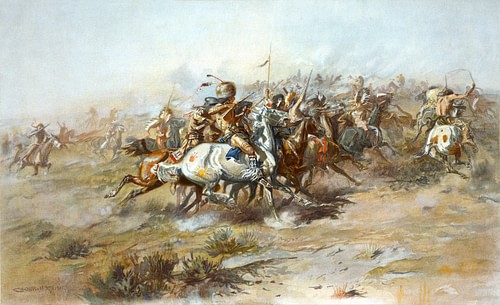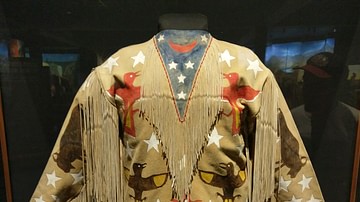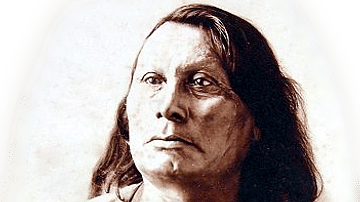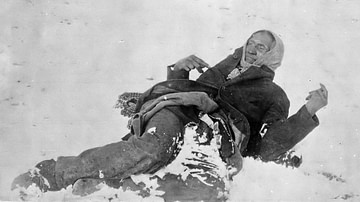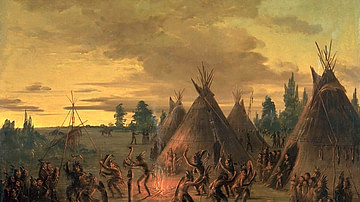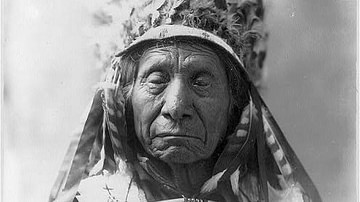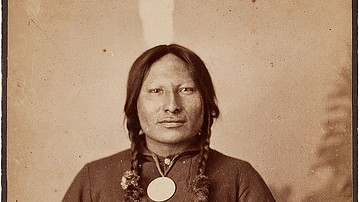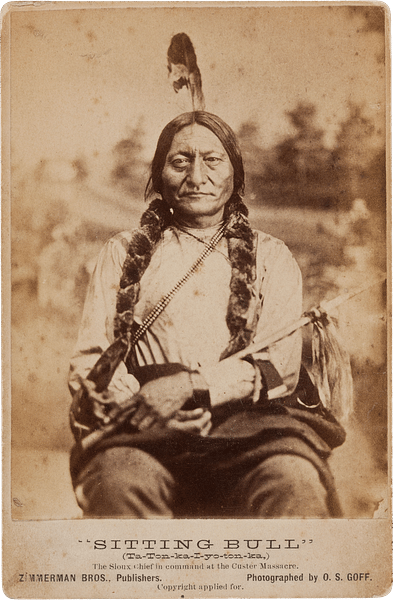
Sitting Bull (Tatanka Iyotanka, l. c. 1837-1890) was a Hunkpapa Sioux holy man, warrior, leader, and symbol of traditional Sioux values and resistance to the United States' expansionist policies. He is among the best-known Native American chiefs of the 19th century and remains as famous today as he was when he led his people.
He is widely known for his part in the Battle of the Little Bighorn in June 1876 and his later celebrity as a performer in Buffalo Bill's Wild West Show, but, for the Sioux, Sitting Bull is celebrated as the embodiment of the four cardinal virtues of his people: courage, fortitude, generosity, and wisdom. He is also recognized for his refusal to abandon the traditions of his people and his efforts to preserve their culture. Although famous as a holy man, prophet, war chief, and hunter, Sitting Bull was also a poet and composer, as well-known among his people for his rapport with wild animals and herbal knowledge as for his leadership.
He was killed while resisting arrest at the Standing Rock Agency Reservation in South Dakota on 15 December 1890 and was buried at Fort Yates in North Dakota. His remains were exhumed by family members in the 1950s and interred at Mobridge, South Dakota, near where he was thought to have been born. Debate continues over whether these remains are those of Sitting Bull, and historians also offer differing views on his legacy. His reputation as a great leader of his people, however, is unchallenged as he continues to be recognized as a symbol of Native American pride, honor, and traditional values, as well as for his stand against injustice.
Youth & Name
Little is known of Sitting Bull's life before the age of 14. His date of birth, given as 1831, 1832, 1834, or 1837, is debated, as was his birthplace until fairly recently. He is now understood to have been born on the Yellowstone River (known to the Sioux as Elk River) in modern-day Montana and was named Jumping Badger (Hoka Psice). He quickly earned the nickname Slow (Hunkesni), owing, according to scholar Robert. M. Utley, to "his willful and deliberate ways" (6). His father was Chief Sitting Bull of the Hunkpapa Sioux, and his mother was Her-Holy-Door from a respectable Hunkpapa family. He had two sisters and a half-brother but would later adopt others as his brothers, and these are sometimes mistakenly referenced as biological siblings.
Chief Sitting Bull taught his son to ride, hunt, and shoot expertly before the boy was ten years old. Young Slow was an excellent shot with bow and arrow and became so closely associated with horses that his peers joked how he even walked as though he were on horseback. When he was 14, he joined a war party against the Crow and "counted coup" against a Crow warrior, knocking him from his horse where he was then killed by another of the party. For this act of courage – defeating an enemy without killing him – Chief Sitting Bull gave his name to his son and assumed the name Jumping Bull. "Sitting Bull" – Tatanka Iyotanka (literally "Buffalo Who Sits Down") – fit the youth's personality as, "according to fellow tribesmen, [the name] suggested an animal possessed of great endurance, his build much admired by the people, and when brought to bay, planted immovably on his haunches to fight on to the death" (Utley, 15).
Later acquaintances and writers would claim the name was given him due to his stubbornness or, according to Sioux writer and physician Charles A. Eastman, that he was given the name after forcing a buffalo calf to sit down. The name was actually given in accordance with the tradition whereby a father passed his own name to his son when the boy was recognized as attaining manhood.
Between the ages of 14 and 20, Sitting Bull led his own war parties, and his name became famous among his enemies as a formidable warrior. Utley describes him at around the age of 20:
A heavy, muscular frame, a big chest, and a large head, he impressed people as short and stocky, although he stood only two inches under six feet. His dark hair, often braided on one side with otter fur and allowed to hang loose on the other, reached his shoulders. A severe part over the center of the scalp glistened with a heavy streak of crimson paint. A low forehead surmounted piercing eyes, a flat nose, and thin lips. Although dexterous afoot and superbly agile mounted, he appeared to some as awkward and even clumsy. (19-20)
Around 1857, in a clash with an Assiniboine band, Sitting Bull spared a 13-year-old boy whom he later adopted as a younger brother. When Sitting Bull's father was killed in battle with the Crow in 1859, the boy took the name Jumping Bull and would remain by Sitting Bull's side for the rest of his life.
Holy Man & Leader
Sitting Bull is often referred to as a "medicine man" – which he was – but he rarely practiced the healing arts like most medicine men. He was known to his people as a Wichasha Wakan – a holy man – as described by Utley:
Wichasha Wakan were dreamers – men who had experienced dreams with sacred content or who had attained visions of powerful spiritual meaning. Not all dreamers were holy men, but all holy men were dreamers. One function of holy men was to help people interpret dreams, for they imposed obligations as binding as a personal vow, and to ignore their content was to invite personal calamity. (28)
Unlike Crazy Horse (l. c. 1840-1877), whose early vision became well known, there is nothing recorded about the experience of Sitting Bull when, as a young man, he went off on his vision quest and understood his path in life. According to interviews he gave later, Sitting Bull claimed he had known his destiny when he was still in his mother's womb and never spoke of his vision quest. He would have engaged in the ritual, however, as it is one of the Seven Sacred Rites of the Lakota Sioux. Whatever his vision was, and whenever he received it, he already had a reputation for wisdom and spiritual power as a young man in his twenties. It was said he could talk to animals and hear their answers and knew all the herbs and plants for healing long before his first military engagements with Euro-Americans in the mid-1850s.
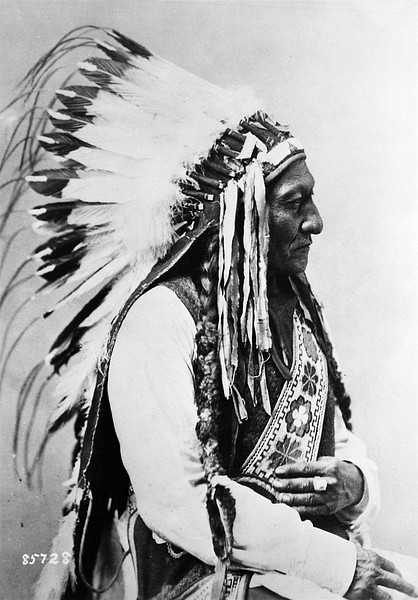
White settlers – in the form of French traders – had been known to the Sioux since at least 1832 through the trading posts established but it was not until after the Fort Laramie Treaty of 1851, which sought to partition the lands of the Plains Indians, that the Native Americans and Euro-Americans routinely clashed. Sitting Bull, already recognized as a great war chief, led raiding parties against white settlers and their wagon trains, driving small groups from Sioux lands or killing them. He was not the chief of the Sioux Nation at this time – or at any other – but a chief of the Hunkpapa Lakota Sioux, a part of the larger Nation – and a highly respected war chief.
Red Cloud's War & Little Bighorn
Although Sitting Bull is usually described as an active participant in Red Cloud's War (1866-1868), it is more accurate to say he launched his own initiatives at the same time as Red Cloud (l. 1822-1909) and supported his efforts. Red Cloud's War was fought to prevent Euro-American expansion into Sioux lands and the establishment of permanent settlements and forts. Red Cloud's initiative aligned with Sitting Bull's, but Sitting Bull never placed himself or his followers under Red Cloud's command.
While Red Cloud struck at Fort Reno, Fort Phil Kearney, and Fort C. F. Smith, beginning in 1866, Sitting Bull attacked Fort Berthold, Fort Buford, and Fort Stevenson as early as 1865, continuing the kinds of raids he had been leading since c. 1855 or earlier. When the US government sued for peace and offered the Fort Laramie Treaty of 1868 – which Red Cloud agreed to – many others refused to sign, including Sitting Bull, Crazy Horse, and Sioux war chief Gall (l. c. 1840-1894). Although Charles A. Eastman (also known as Ohiyesa, l. 1858-1939) in his Indian Heroes and Great Chieftains (1916), claims that Sitting Bull signed the treaty of 1868, this is unsupported by other sources as well as by Sitting Bull's actions between 1868-1877 and his own words.
Assured of the preservation of Sioux lands by the treaty, Red Cloud kept the peace and moved with his people to the reservation. The later claim that, at this time, Sitting Bull became Chief of the Sioux Nation is incorrect and based on the Euro-American understanding of Red Cloud holding that position. With Red Cloud on the reservation, the next most visible Sioux leader was Sitting Bull who, essentially, continued Red Cloud's War in his own way. He attacked the settlers who continued to arrive in Sioux lands, even though the Fort Laramie treaty had promised none would, in 1869-1871, as well as the surveyors for the Northern Pacific Railway and the military escorts sent to protect them.
In 1874, Lt. Colonel George Armstrong Custer (l. 1839-1876) led an expedition into the Black Hills – sacred to the Sioux – where he discovered gold, leading to the Black Hills Gold Rush of 1876, which completely ignored the stipulations of the Fort Laramie Treaty of 1868. Sitting Bull did not engage with Custer's command but continued his attacks elsewhere. In November 1875, President Ulysses S. Grant (served 1869-1877) issued orders for all Sioux to move onto the Great Sioux Reservation by 31 January 1876 and any who did not would be considered "hostile" and subject to prosecution.
Sitting Bull had no intention of complying with Grant's orders and, instead, welcomed their allies, the Northern Cheyenne and Arapaho, to his camp on the Little Bighorn River (known to the Sioux as the Greasy Grass River) where, on 25 June 1876, they were surprised by Custer and other commanders, including Major Marcus Reno. Sitting Bull had experienced a vision of complete victory in an upcoming conflict, but when the Battle of the Little Bighorn began, he was sleeping (according to Charles Eastman), and his two main war chiefs, Crazy Horse and Gall, were caught off guard. Still, they organized and responded quickly, killing Custer and scattering the US 7th Cavalry.
Exile & Celebrity
The Battle of the Little Bighorn (known by the Sioux as the Battle of the Greasy Grass) was a stunning Native American victory, but the US military retaliated instantly, and the Sioux and Cheyenne leaders all went their own ways seeking safety. Sitting Bull, and Gall with him, went north while Crazy Horse moved haphazardly to avoid engagements with US forces. In September 1876, General George Crook (l. 1828-1890) led his command against the camp of the Oglala Sioux Chief American Horse the Elder (l. c. 1830-1876) – who had not even been present at Little Bighorn – and destroyed it at the Battle of Slim Buttes (9-10 September 1876). Crazy Horse tried to relieve American Horse, but his charge was broken by Crook's defensive position and repeating rifles. American Horse was wounded, dying later, and Crazy Horse fled the field.
Sitting Bull, meanwhile, had been living off the land and evading US troops, but in May 1877, he led his people into the region of modern-day Canada, hoping to find safety and support from the government. In September 1877, Crazy Horse was murdered by a guard at Fort Robinson, leaving Sitting Bull and Gall as the last two Sioux war chiefs who had not surrendered. Sitting Bull and Gall remained in Canada for four years – their people constantly trying to find resources to sustain themselves – and, toward the end of that time, Gall broke with Sitting Bull (his adopted brother and mentor), feeling his stubborn stand against the U.S. would result in the starvation of all, and returned to the United States to surrender. Gall was first treated as a prisoner of war and then moved to Standing Rock Agency, where he later became a judge and advocate for peace. Sitting Bull followed Gall back to the U.S. in July 1881, ending his exile.
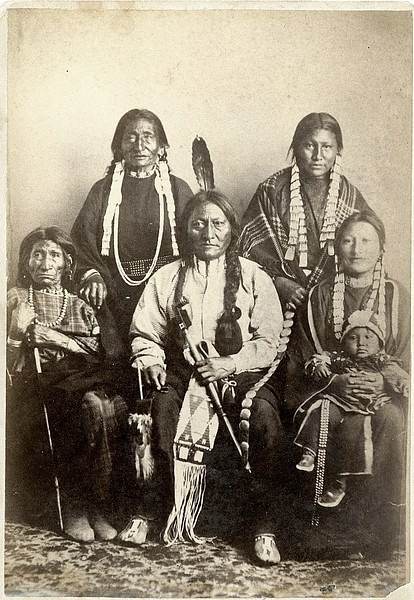
He surrendered to Major David H. Brotherton at Fort Buford, asking his son, Crow Foot, to hand over his rifle to the authorities in his now-famous speech:
I surrender the rifle to you through my young son, whom I now desire to teach in this manner that he has become a friend of the Americans. I wish him to learn the habits of the whites and to be educated as their sons are educated. I wish it to be remembered that I was the last man of my tribe to surrender my rifle. This boy has given it to you, and he now wants to know how he is going to make a living. (Utley, 232)
Sitting Bull and his followers were then sent to Fort Yates near the Standing Rock Agency Reservation where they were taught to be farmers, with varying degrees of success. In 1884-1885, Sitting Bull toured North America, first as part of the "Sitting Bull Combination" and then with Buffalo Bill's Wild West Show. He was already a celebrity, the notorious "killer of Custer", but his time in show business made him even more famous.
He became close friends with the sharpshooter Annie Oakley (l. 1860-1926) and, of course, with Buffalo Bill Cody (l. 1846-1917), who had once been a major proponent of the slaughter of the buffalo to deprive the Plains Indians of food. Audiences adored him, even though he was only a small part of the Wild West Show, and he made a significant amount of money charging people for his photo and autograph, although, in keeping with his values, he usually gave whatever he earned away to the needy.
Conclusion
After his travels, Sitting Bull returned to the Standing Rock Agency Reservation and the task of trying to learn to be a farmer. In 1889, the activist and artist Caroline Weldon (l. 1844-1921) arrived with her son Christie to help the Sioux retain their lands after the Dawes Act of 1887 had broken up the Great Sioux Reservation to create the states of North and South Dakota. Weldon became a close friend of Sitting Bull and painted four portraits of him while also serving as his interpreter and secretary. Their relationship is dramatized in the 2017 film Woman Walks Ahead.
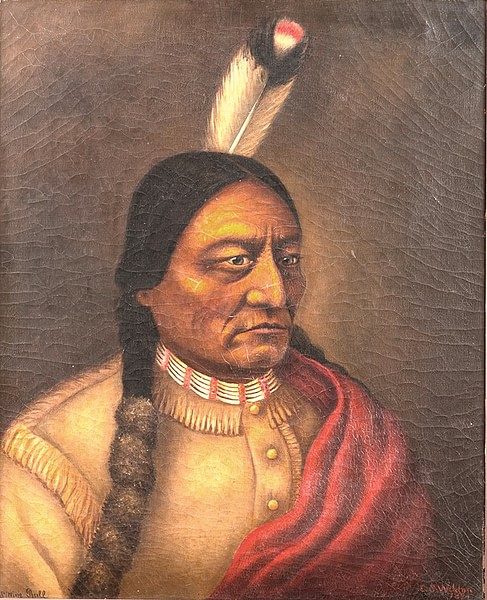
That same year, 1889, the Paiute prophet Wovoka (also known as Jack Wilson, l. c. 1856-1932) began preaching the spiritual vision of the Ghost Dance, a non-violent, religious movement which included a moral code and the performance of a round dance, which he claimed would bring the dead back to life, restore the buffalo, drive the white people from the land, and return the lives of the Plains Indians to what they had been before the white man arrived.
Sitting Bull had nothing to do with the Ghost Dance. It was brought to his attention by the Oglala Lakota Sioux Chief Kicking Bear (l. 1845-1904), who had visited Wovoka and believed in the movement. Sitting Bull granted him permission to perform the dance at Standing Rock Agency and seems to have supported the movement, but he did not participate. Weldon criticized his support as she believed the Ghost Dance would give the government an excuse to send the military against the Sioux as they would interpret the movement as a rebellion. Sitting Bull rejected her claims, driving a wedge between them, and Weldon left the reservation with her son in November 1890.
Weldon's objections proved prophetic, however, as Indian Agent James McLaughlin (l. 1842-1923) interpreted the Ghost Dance as an act of defiance of US policies and feared it was a prelude to rebellion, asking for more troops to be deployed in the region and ordering the arrest of Sitting Bull, who he believed to be the ringleader and inspiration for the movement. On 15 December 1890, Sitting Bull was shot dead by the Native American police officers sent to apprehend him. His son, Crow Foot, and adopted brother Jumping Bull were also killed in the altercation. The Ghost Dance would also provoke the Wounded Knee Massacre of 1890 later that same month.
Sitting Bull's remains were buried without ceremony at Fort Yates, North Dakota, and according to Eastman, some Sioux women later built a cairn on his grave as a show of respect. In the 1950s, family members exhumed his remains and brought them to Mobridge, South Dakota, which was then believed to be his birthplace, but it was later claimed these were not truly Sitting Bull's remains, and, today, both North Dakota and South Dakota claim his "true" grave. To many, however, Sitting Bull still lives on in spirit, and where his earthly remains are buried does not matter, as he continues to serve as an inspiration today in the resistance to injustice, just as he did while he lived.
